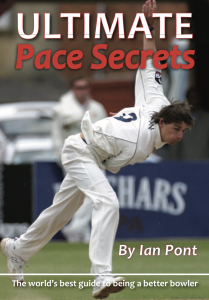Ultimate Pace Foundation Relaunch: Anyone Can Be, With Us


Ultimate Pace Foundation (UPF) is an online cricket coaching platform created and started in 2018 by Ian Pont.
The idea behind our brand was to invite, inspire and challenge fast bowlers to achieve their greatness.
And with Ian being one of the world’s best fast bowling coaches, there was no question that our students would become impressive too.
Ian has worked with two of the finest fast bowlers of all time in South African Dale Steyn and Pakistan’s Shoaib Akhtar. He has students ranging from IPL T20 star Deepak Chahar and Afghanistan’s superstar white ball bowler Naveen-Ul-Haq to up-and-coming young quicks across the globe. Ian is Head of The National Fast Bowling Academy in the UK.
Combined with the knowledge of Ireland international & T20 World Cup player Catherine Dalton and the technical prowess of Mark Sheppard who is an expert in human movement and the developer of the Power To Perform course, we provide a rounded foundation for both up-and-coming and established bowlers.
Our core belief is that fast bowling is for anyone, not just for the select few.
“But, how can you coach me when you’ve never seen me?”
The motivation behind the information is that, if you are able to identify the common mistakes made in fast bowling, you can use the proven solutions and become your own coach.
The goal is to turn youinto the best coach you have ever had.
Give a player a cricket ball, he’ll bowl for a day..
…teach a player to bowl, and he’ll bowl for a lifetime.
The Ultimate Pace Foundation is about self-education, and once you have the information that our website provides, you can start coaching yourself. Our website was designed to share the most pertinent information about fast bowling easily and effectively.
Our website guides you through the bowling system on the premise that every person uses the same process, but with the ability to use the information for wherever you are in your journey.
As long as you understand every fast bowler uses the same movements but simply in their own way, you can easily use your own style – this is at the heart of UPF’s teachings.
We bring cutting-edge, world-class coaching directly to people’s phones, tablets and laptops. Proven, successful coaching methods used by some of the best fast bowlers playing the game, are now available to everyone. Great information that works is right here, at your fingertips.
And now, UPF is relaunching its brand into 2021.
Why the relaunch?
Re-establishing UPF Cricket as the world’s leading fast bowling brand is important because so far, we have been fast bowling’ best-kept secret.
The relaunch has a new look, an even more simplified access and a straightforward, no-nonsense approach to fast bowling information.
We listened to the thousands of people who enjoy our content, and have made it even more mobile-friendly. If you want more pace, there’s only one place – but UPF Cricket gives you so much more than that.
In short, there is nothing better than having a personal fast bowling coach in your pocket.
What does the future look like?
Coaches are now realising UPF Cricket offers a way to teach what has been, previously, a little-known subject.
We are seeing an uplift in coaches, parents, and educators who want to add an extra set of tools to their understanding of cricket.
We know of cricket centres who follow our coaching methodology, and are achieving far better results than those that are not. This shows us that our brand is strong and is actually – and actively – making a difference.
Become Your Own Best Coach
When you can make a difference to the standard of bowlers who use our methods, that is what it’s all about. The feedback and loyalty from people is heartening.
Many bowlers have been desperate to find this type of help and support, and have discovered UPF Cricket. We are here to help players get better, whatever level they play.
That’s why we have beginners, intermediate, top level, elite, professional and even international players accessing our site.
Everything you could possibly need to know about how to be a successful fast bowler, you can get from our website. That makes it the finest investment you could ever make in your future.

 We have not yet agreed any coaching dates for camps due to COVID-19. But we do hope to have some UPF camps arranged in the near future!
Please revert back regularly to check.
We have not yet agreed any coaching dates for camps due to COVID-19. But we do hope to have some UPF camps arranged in the near future!
Please revert back regularly to check. 





Really interesting concept with the levels per discipline I think that parents quite often do presume a coach to know what hes doingbased on their ECB level of qualification